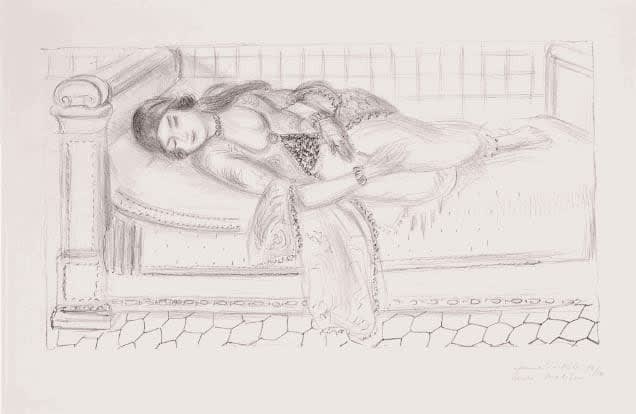
Early Life and Artistic Beginnings
Henri-Émile-Benoît Matisse was born on December 31, 1869, in Le Cateau-Cambrésis, a small town in northern France. His early exposure to art came from his mother, who painted porcelain, and his own childhood sketches. However, it wasn't until he moved to Paris and began studying at the Académie Julian in 1891 that his formal artistic education began.
Matisse's early works were heavily influenced by the academic style of the time. He painted still lifes, landscapes, and portraits with a traditional, realistic approach. This academic training laid the foundation for his future artistic explorations, as he learned the fundamentals of composition, form, and colour.
Fauvism: The Bold Departure
The turning point in Matisse's career came with the emergence of Fauvism, an avant-garde art movement that rejected traditional colour palettes and embraced bold, non-naturalistic colours. Matisse's iconic painting, "Woman with a Hat" (1905), is a prime example of this new style. The shockingly vibrant and arbitrary use of colour in the portrait marked a radical departure from his earlier academic works. The Fauvist movement, of which Matisse was a central figure, was characterised by its expressive use of colour and form.
Matisse's influence on Fauvism went beyond his own work. He inspired and mentored other artists such as André Derain and Raoul Dufy, who also played pivotal roles in the movement. The Fauvist approach to colour and form would leave a lasting impression on modern art, paving the way for future movements like Expressionism and Abstract Expressionism.
The Dance of Abstraction
In the early 1910s, Matisse's artistic journey took another intriguing turn. He began to explore abstraction and simplification of form, evident in his masterpiece series "The Dance." These works depict a group of dancers in various dynamic poses, with a strong emphasis on rhythm and movement. The figures are reduced to essential shapes and lines, capturing the essence of the dance rather than attempting a realistic representation.
"The Dance" series showcases Matisse's evolving interest in breaking free from conventional representation and embracing the power of abstraction. This transition was not just a personal exploration but a significant contribution to the broader shift in modern art towards abstract and non-representational forms.
Cut-Outs: A Late Career Revelation
One of the most remarkable phases of Matisse's career came in the 1940s when he turned to cut-outs. Suffering from health issues that limited his mobility, Matisse found a new way to create art. He began cutting shapes from painted paper and arranging them into compositions. This innovative technique resulted in iconic works like "The Snail" (1953).
Matisse's cut-outs are characterised by their vibrant colours, playful compositions, and a sense of limitless creativity. The simplicity of form and the interaction of colours in these works are a testament to his ability to adapt and innovate throughout his life. The cut-outs are a beautiful example of how constraints can lead to artistic breakthroughs.
Legacy: Matisse's Enduring Influence
Henri Matisse passed away on November 3, 1954, leaving behind a legacy that continues to inspire artists and art enthusiasts alike. His influence on modern art is immeasurable and can be observed in various ways:
Abstract Art
Matisse's exploration of abstraction in "The Dance" series and his later cut-outs paved the way for the development of abstract art. Artists like Piet Mondrian and Kazimir Malevich were influenced by Matisse's bold use of abstraction.
Expressionism
Matisse's Fauvist works had a profound impact on Expressionism, another important modern art movement. Expressionist painters sought to express raw emotionmuch like Matisse did in his Fauvist works.
Cut-Outs
Matisse's cut-out technique inspired a new generation of artists, including the likes of David Hockney and Robert Rauschenberg, who experimented with collage and cut-paper techniques in their work.
Colour Theory
Matisse's deep understanding of colour theory and his fearless use of colour combinations continue to influence contemporary artists, especially in the fields of interior design, fashion, and graphic design.
Freedom of Expression
Above all, Matisse's legacy teaches artists the importance of pushing boundaries, breaking away from conventions, and embracing the freedom to express oneself through art.
Henri Matisse's influence on modern art is undeniable. His journey from academic training to Fauvism, abstraction, and finally, the innovative cut-outs, reflects his willingness to evolve and experiment throughout his career. Matisse's work not only shaped the development of art in his time but continues to inspire and guide artists today. His legacy serves as a testament to the power of creativity, innovation, and the enduring impact that art can have on the world. Matisse's influence on modern art is a story of boundless imagination, bold experimentation, and the enduring power of artistic expression.
Explore our collection of Matisse original art for sale and contact Andipa via sales@andipa.com or call +44 (0)20 7581 1244.